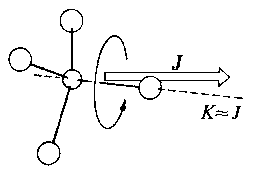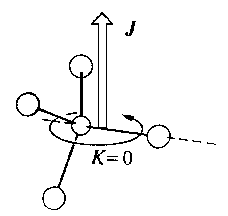Symmetric Top ![]()
Examples: CH3I, C6H6, NH3
| If we denote I|| as the moment of inertia parallel and I⊥ orthogonal to the molecule's axis, we have two cases: For I|| < I⊥ we have a rotator similar to a record which is said to be of oblate type. Otherwise, with I|| > I⊥ the rotor is of prolate type that may remind us of a cigar. Within the world of atoms and molecules, benzene is an example for the first, methyliodide an example for the latter. For both types, the rotational energy is composed of two components |  |

The transition to quantum mechanics is eased by the fact that the energy values respective J2 and one selected axis are recieved simultaneously. For J2, which is

the energy values are defined by

We now replace the square of the angular momentum by the eigenvalues of the
quantum mechanical angular momentum operator J2 →
J(J+1)h2 and use K for the eigenvalues that
correspond to a projection of the momentum onto the molecules axis (i.e.
JCΨ → KhΨ). For the quantum mechanical
energy levels, we finally obtain:
 |
K = 0, ±1, ±2, ..., ±J J = 0, 1, 2, ... B = A = |
| We now consider two extreme cases of a rotating symmetric top | ||
 |
 |
Obviously, the sign of K does not affect the energy as it is dependents on the square of K. Therefore, all levels are doubly degenerate. But as there are the 2J+1 additional possibilities for angular momentum, respective of an external axis (MJ = 0, ± 1, ± 2, ± 3, ... ± J), the energy level of a symmetric top is but 2(2J+1)-fold degenerate. For K = 0 we have the exception of (2J+1)-fold degeneracy. Though there is no definition for clockwise/anti-clockwise and +/−, the sign indicates two possibilities of rotation with identical energy. |
| a) around the molecule's axis | b) perpendicular to the molecule's axis | |
For the first extreme with |K| = J, where J reaches a maximum with respect to the molecules's axis, the rotation is mainly around this axis and rotational constant A (resp. I||) is decisive for the energy levels.

For the other extrem of K = 0, the molecule rotates perpendicular to its axis. Therefore, the projection of the angular momentum on the axis is zero and the rotational energy becomes

![]()
Auf diesem Webangebot gilt die Datenschutzerklärung der TU Braunschweig mit Ausnahme der Abschnitte VI, VII und VIII.